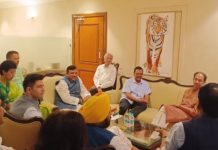 Tuplal Das’ clear voice rings out in Hindi. After greeting his audience, he introduces himself as a member of Lahanti, a Santhali youth club based in Bihar’s Jamui district. In an audio message running for over two minutes, he explains school students how washing hands is the key to maintaining good health, especially in the time of Covid-19. In another audio, Das talks about BR Ambedkar, the father of the Indian Constitution.
Tuplal Das’ clear voice rings out in Hindi. After greeting his audience, he introduces himself as a member of Lahanti, a Santhali youth club based in Bihar’s Jamui district. In an audio message running for over two minutes, he explains school students how washing hands is the key to maintaining good health, especially in the time of Covid-19. In another audio, Das talks about BR Ambedkar, the father of the Indian Constitution.
Such short meaningful audio clips are helping students stay connected with studies in the villages of Jamui’s Chakai block in the absence of learning resources like laptops, internet and smart phones during school closure. Recorded by the members of Lahanti, these audios are broadcast through Chirag vaani, a community-based radio initiative. Das, a resident of Chakai, joined Lahanti four months back. Speaking about the audio clips, which are benefitting mostly primary school Santhali students, Das said, “Education is in a shambles in the rural areas of India and often teachers do not engage with students in a proper manner. As Santhali students are not taught about their community’s tradition, history and culture in schools, I try my best to give them valuable information and make the audio messages interesting,” he added.
The concept of Chirag vaani is based on learning through listening. Most users are first-generation learners. It is a missed call-based technology for non-smart phone users with options like skip and feedback.
For listening to the audio clips which are being broadcast in both Santhali and Hindi, one has to give a missed call on the number 9278702369 from any basic phone. There is a dedicated education hour daily from 10am to 12pm.
Using IVRS technology
As Santhal children are compelled to learn Hindi in schools and speak their mother tongue Santhali at home, at times communication gaps arise in classrooms. In such situations, teachers fail to understand what the students want to convey.
To overcome this problem, Sinchan Foundation, a non-profit based in Chakai, helped organise extra after-school classes for two hours before the lockdown was announced. As part of this, a few Lahanti club members used to help Santhali children overcome the language barrier. In Jabardaha and Govindpur villages of Chakai, these classes were held in government schools with full support from teachers and targeted mainly primary students.
Government school teacher Manoj Kumar Burnwal said that before the lockdown, Lahanti club used to depute a few dedicated members to teach lessons in Santhali to students after school hours. “This is most helpful as they speak Santhali at home with parents. Even though my school is in a Santhali area, teachers do not know the language,” he added.
Sinchan founder Gautam Bisht pointed out that as many Santhali children struggle with Hindi, sometimes teachers fail to understand what students want to convey, like for instance, something as basic as seeking permission for going to washrooms. “To aid the process of helping students as well as teachers, Santhali to Hindi and Santhali to English dictionaries were prepared. We covered 180 students in four villages of Chakai under extra classes,” Bisht added.
However, after the schools closed due to Coronavirus, the interactive voice response system (IVRS) technology was accessed to teach students with the help of audio clips and Lahanti club members were roped in for the initiative.
According to Bisht, the Santhal pedagogy creatively uses poems, stories, jokes, conversations, dance, music, songs and wall paintings for teaching. “Initially, we chose history because it is basically storytelling and can be easily narrated through audio clips. Now, lessons on geography, social science and science have been included. Every week, six
audios are recorded. We also ask for feedback at the end of each audio.”
The IVRS system gets about 800 calls per week. Samel Besra, a Class 6 student, regularly listens to these clips. Class 8 student Pankaj Kisku from Phitkoriya village said the clips touch upon several important things not taught in schools. While Kajal Hansda, who is in Class 4, likes hearing Hindi stories retold in Santhali, Anita Marandi, a class 3 student, loved an audio made on social reformer Savitribai Phule.
“One can call anytime and listen to these audios apart from the dedicated student hour,” said Lahanti member Kusum Hansda.
Helping children learn
Sinchan co-founder Shuvajit Chakra-borty said rural students are facing difficulties as they have limited options for staying in touch with lessons. So, in this crisis hour, they are seeking the help of audio clips.
“We are developing a model which can be used even by the government in future in case it wants to. Our dream is to spread this model to other Santhal-dominated areas as well like the Santhal Parganas in Jharkhand. But we are not expanding immediately without proper evaluation,” Chakraborty added.
Apart from Chakai, dedicated members from West Bengal, are also recording audio clips by connecting with Lahanti on Facebook. One such person is Bishwajit Hembrom, a B.tech student from Siliguri. Hembrom, who has made an audio on scientist Thomas Alva Edison, feels honoured to contribute something meaningful to children’s education.
 While audios on scientists like Edison, Issac Newton and Albert Einstein are appreciated by students, audio messages on history has touched upon Chandragupta Maurya, the founder of the Mauryan empire, and the Indus Valley civilization. Children are also told about key Santhal leaders like Sidhu Murmu and Kanhu Murmu, who took part in the Santhal rebellion against the British as well as women leaders like Phulo Murmu and Jhano Murmu.
While audios on scientists like Edison, Issac Newton and Albert Einstein are appreciated by students, audio messages on history has touched upon Chandragupta Maurya, the founder of the Mauryan empire, and the Indus Valley civilization. Children are also told about key Santhal leaders like Sidhu Murmu and Kanhu Murmu, who took part in the Santhal rebellion against the British as well as women leaders like Phulo Murmu and Jhano Murmu.
Lahanti club member Prem Besra takes up to three days to record an audio. Such an initiative ensures that Santhal students move forward and stay ahead in society. “As I myself faced the language barrier in school due to my poor knowledge of Hindi, I understand the problem quite well.”
Kavita Marandi, who has mostly recorded history lessons and narrated Hindi stories in Santhali, said students in urban areas are learning through smart phones and internet. But in villages, most people lack these facilities because of financial constraints. So, these audios help children take interest in studies when classes are not being held.
“We have to carefully choose our topics as textbooks contain several chapters. Ensuring that children do not get bored is also vital. Before recording, I read, understand the subject and write down my audio message in Santhali. Then I think of ways to narrate it interestingly. I also put songs and dialogues in between while recording on my phone.” Marandi has made 10-15 audio clips, which are sent to Bisht before being broadcast.
Hansda often sings in her beautiful voice while recording and has made over 25 clips till now. In an audio, she talks about Mahatma Gandhi and the freedom struggle in Santhali and starts with a song. Through Chirag Vaani, which is being run by Mobile Vaani, a voice-based social networking for rural India, one can listen as well as record. “It is a two-way communication system,” said Sayonee Chatterjee, director, Mobile Vaani, child rights and gender.
Though callers use a toll-free number, the missed call system has been devised because most people in villages have this misconception that they will be charged later, Bisht added. While till June, five minutes was the average listening time, it now stands at seven minutes. “Some 400 students are regularly attending classes through Chirag Vaani. Apart from this, the IVRS server tells us that almost 4,000 children and their parents had called on the platform,” Chakraborty pointed out.
letters@tehelka.com












